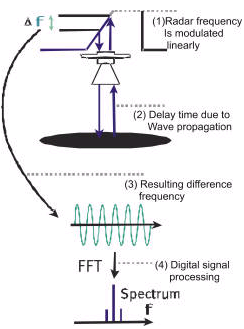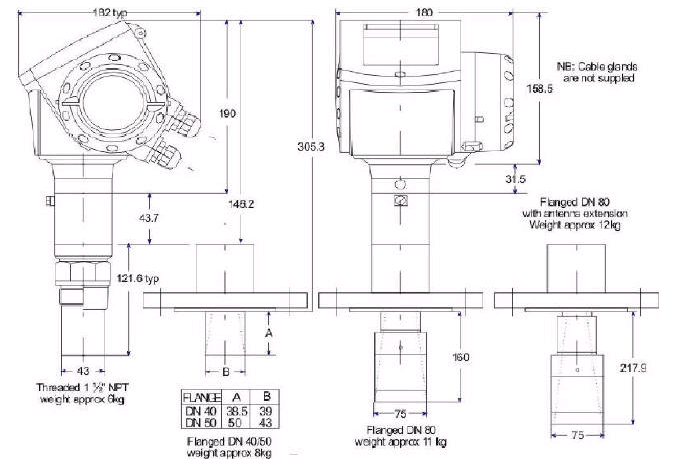The VG7 High frequency (26 GHz) Radar operates on the same proven principle of the earlier lower frequency 10 GHz FMCW Radars.
A radar signal is emitted via an antenna, reflected by the target level and received after delay time ‘t’
The high frequency signal (~26GHz) increases linearly by 2GHz during the measurement (frequency sweep) (1). The signal is emitted, reflected from the target surface and then received at a time-delayed frequency (2).
The difference Df, is calculated from the actual transmitted frequency and the received frequency (3). This difference is directly proportional to the distance measured The frequency difference is processed via a Fast Fourier Transformation (FFT) into a lower frequency spectrum and the actual distance / tank level is calculated from this spectrum.
Compared to the earlier 10 GHz units the main technical advantages are:
Stable, crystal-controlled high transmit frequency of 26 GHz and a larger bandwidth of 2 GHz a Dynamic range more than 100 dB.

Digital signal processing provides very high computing capacity. Complex evaluation algorithms ensure reliable and precise calculation of measured values.
The high average transmit frequency of 26 GHz provides better concentration and focus of the microwave signals, for improved accuracy, stability, and sensitivity, of the measured value.
The large 2 GHz bandwidth makes it easier to distinguish between wanted and unwanted signals, and measured values are evaluated with greater accuracy.
A dynamic range of more than 100 dB is attained using the FMCW principle. This determines the ratio between the strongest valid signals and the weakest possible signals in the form of fundamental noise.
The unique Tank Bottom Following (TBF) mode enables products with low dielectric constants to be measured. For tanks with complex internal structures the Empty Tank Spectrum (ETS) can damp out all unwanted reflections from in tank obstructions.


